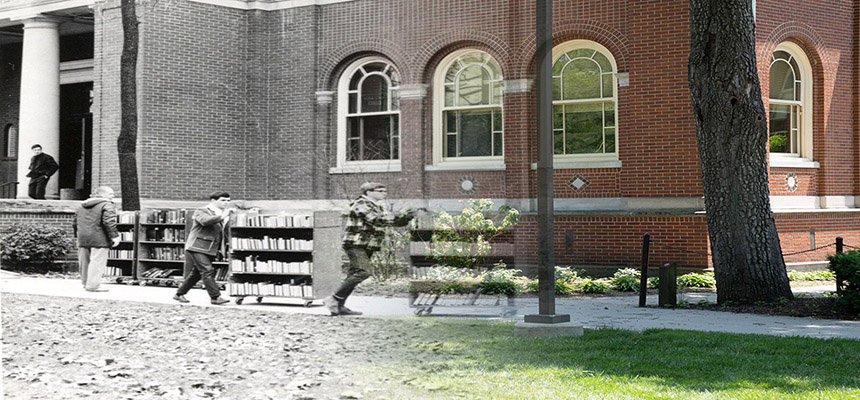Weave the Story
(Image from Miami University Library Instagram)
Weave the Story: Teaching Old Miami/New Miami
This site describes the origins, experiences, and learning outcomes of the 2021-22 Faculty
Learning Community “Weave the Story: Teaching Old Miami/New Miami.”
Why University Instructors Should Learn About Their Institutional History
What responsibility do faculty have in understanding and disseminating the histories of
the places where they teach? Campus-wide conversations on an institution’s history and
traditions can build a shared sense of culture as well as improve the learning experiences
we provide to our students.
A Faculty Learning Community on Miami’s History
Our Faculty Learning Community (FLC), “Weave the Story: Teaching Old Miami/New
Miami,” was based in our commitment to engaging in a campus-wide conversation on
Miami’s University’s history and traditions.
The Mission of the FLC
The American residential college is often depicted as a kind of detached oasis: a place students move to temporarily in order to immerse themselves in their studies and prepare for entry into the “real world.” Such narratives, of course, ignore the experiences of so-called “non-traditional students” (who are a growing majority of those who attend college nationally) and overlook the fact that universities are very much embedded in place and have their own histories that extend beyond the traditions and lore touted as part of an institution’s brand. When we were hired as faculty at Miami, we cannot recall ever having received resources or instruction about Miami's history and traditions. In order for an institution like Miami, now almost two decades into our institution’s second century, to sustain itself, and to grow its own sense of self within the city of Oxford, the State of Ohio, and beyond, we believe this must change. We believe that an honest and sustained campus-wide conversation on our history and traditions will build a sense of solidarity to be shared by faculty, students, alumni, and staff as well as enhance the instruction and history we can provide to our students. Thus, in our FLC, conducted during the 2021-2022 academic year, Miami faculty from across the humanities, arts, and sciences came together to consider how incorporating the history of Miami into our classes could enrich our students’ understanding of place, prompt more meaningful engagement within their local community, and better achieve learning outcomes in our respective fields.
Building an Instructional Resource on Miami’s History
How might faculty engage students in local and institutional history across the curriculum to enrich their educational experience at a residential university? Our FLC set out to explore this question and provide potential solutions.
The Work of the FLC
This FLC built upon years of meaningful research by our colleagues, such as the many initiatives of the Myaamia Center, the important archival and public work of the University Archives, and the multiple volumes of Miami history penned by faculty. Miami University, 1809-2009: Bicentennial Perspectives (Miami University Press, 2009), a volume edited by History Professor Curtis W. Ellison, was our touchstone text for the first semester of this year-long inquiry. As we worked through the book, we developed critical questions and possible classroom activities to engage each moment in Miami’s history. In the second semester, each faculty member built upon this knowledge and skillset to author specific assignments and curriculum interventions in their own fields.
Research indicates that an educational institution that invests in honest conversations on history, tradition, and culture improves student retention and faculty morale (see, for example, Macneil, Prater, & Busch, 2009, “The Effects of School Culture and Climate on Achievement,” International Journal of Leadership in Education, 12, 73-84; Paperson, A Third University Is Possible, University of Minnesota Press, 2017). In the experience of several of the participants who taught elements of the work developed in this FLC, students reported more profound learning outcomes and a shared sense of investment in Miami’s community as a result of their experiences.
Implementing an Instructional Resource on Miami’s History
As part of their year-long odyssey of learning together, members of the FLC created assignments for adoption by faculty in their own courses.
Example Assignments Created by FLC Members
The assignments we present here were written with wider possible adoption in mind and hopefully function as launching pads for faculty to explore how to incorporate place and local history into their
own courses. At the conclusion of each assignment, we reflect on our pedagogical approaches and what we hope colleagues from across the university might take away. We hope that this is not merely the summation of our work with the FLC but a starting point for a broader campus resource on how to, in the words of Miami’s alma mater, “weave the story” of this institution into our classes.
FLC Members
Annie Dell'Aria (Art) and Nathan French (Comparative Religion) [FLC Co-Facilitators], Elena Albarran (History), Sasha Bellman (Media, Journalism, & Film), Stephanie Danker (Art), Jason Palmeri (English), Carrie Sharitt (Biology), Cameron Shriver (History), and Carolyn Slotten (Family Science & Social Work)
Acknowledgments
The participants would like to thank Liz Wardle (English, Howe Center for Writing Excellence), Mandy Olejnik (Howe Center for Writing Excellence), Jennifer Blue (Physics), and Curtis Ellison (Professor of History Emeritus) for their support for this learning community as well as the Miami University Center for Teaching Excellence for making this FLC and web resource possible.


